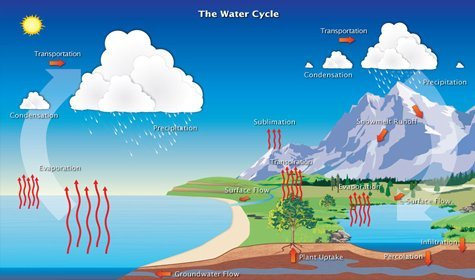The Natural Resources Conservation Service (NRCS) recognizes the lack of water from time to time that occurs within Austin County as well as neighboring counties. We experienced one of the worst droughts that this country has seen just a few short years ago. How we manage our grasslands and cropland goes hand-in-hand with the Water Cycle, no matter the amount of rain we have received.
Having a good understanding of the Water Cycle and protecting the soil from erosion and increasing the water holding capacities will help increase crop yields and produce more forage for livestock on less rainfall.
Water is usually the limiting factor in grassland production. The moisture we receive in every raindrop may be used productively on the site where it falls. It may go downstream as clean water or it may carry parts of the soil on which it fell. When runoff water is dirty, it is taking a little of the potential of the land with it. All that potential adds up to losses for you and your land. When falling raindrops strike bare soil, the impact causes both splash erosion and soil compaction. This results in faster runoff and increased erosion. A good plant cover slows down or breaks the force of the raindrops and allows the water to move into the soil. The soil is like a bank for rainfall, or more accurately, it is a large reservoir for moisture storage which helps reduce flooding issues. This enhances the water quality and promotes a greater and more consistent supply of forage. Coarse textured soil (sandy soils) takes in water faster than fine textured soil (clay soils), but stores less of the water within the root zone of plants. Water moves below the root zone of the plants and recharges groundwater but may sometimes re-appear down slope in a spring or in a creek. Because this movement through the soil is slow, the water supply downstream is cleaner and its flow occurs over a long period of time. Where surfaces are bare, less moisture enters the soil and much of the water stored may evaporate during hot windy days instead of being used for plant growth.
A healthier and more productive water cycle is the result of proper grazing. This management increases plant cover and most certainly reduces potential soil erosion. Plants and the organic matter that they produce affect the water cycle in several ways. They break the impact of the raindrop, and the organic matter acts as a sponge that holds water and slows runoff. The more time for water concentration on your property means more time for that water to move into the soil.
Plant roots increase soil porosity so water moves more readily into and through the soil. They also hold the soil particles in place and reduce erosion. A vigorous plant cover is an important part of influencing the water cycle and making effective use of the precipitation falling on our pastures. If you would like more information about the water cycle or important grazing information that can help your operation, please contact your local NRCS office located in Bellville, TX. (979)865-3139 ext. 170

